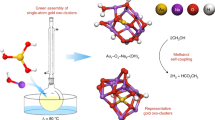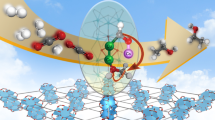Abstract
The lack of selectivity for the direct amination of alcohols with ammonia (a modern and clean route for the synthesis of primary amines) is an unsolved problem. Here, we combine first-principles calculations, scaling relations, kinetic simulations and catalysis experiments to determine the key factors that govern the activity and selectivity of metal catalysts for this reaction. We show that the loss of selectivity towards primary amines is linked to a surface-mediated C–N bond coupling between two N-containing intermediates: CH3NH and CH2NH. The barrier for this step is low enough to compete with the main surface hydrogenation reactions and it can be used as a descriptor for selectivity. The activity and selectivity maps (using the C and O adsorption energies as descriptors) were combined for the computational screening of 348 dilute bimetallic catalysts. Among the best theoretical candidates, Co98.5Ag1.5 and Co98.5Ru1.5 (5 wt% Co) were identified experimentally to be the most promising catalysts.
This is a preview of subscription content, access via your institution
Access options
Access Nature and 54 other Nature Portfolio journals
Get Nature+, our best-value online-access subscription
$29.99 / 30 days
cancel any time
Subscribe to this journal
Receive 12 digital issues and online access to articles
$119.00 per year
only $9.92 per issue
Buy this article
- Purchase on Springer Link
- Instant access to full article PDF
Prices may be subject to local taxes which are calculated during checkout







Similar content being viewed by others
Data availability
The data that support the plots in this paper and the other findings of this study are available from the corresponding authors on reasonable request.
Code availability
The script used for the modified microkinetic simulations using the open source CatMAP code is given in Supplementary Data 2.
References
Brown, B. R. Organic Chemistry of Aliphatic Nitrogen Compounds (Oxford Univ. Press, New York, 1994).
Rappoport, Z. The Chemistry of Anilines (Wiley, Chichester, 2007).
Lawrence, S. A. Amines: Synthesis, Properties and Applications (Cambridge Univ. Press, Cambridge, 2004).
Pera-Titus, M. & Shi, F. Catalytic amination of biomass-based alcohols. ChemSusChem 7, 1–4 (2014).
Guillena, G., Ramón, D. J. & Yus, M. Hydrogen autotransfer in the N-alkylation of amines and related compounds using alcohols and amines as electrophiles. Chem. Rev. 110, 1611–1641 (2010).
Dobereiner, G. E. & Crabtree, R. H. Dehydrogenation as a substrate-activating strategy in homogeneous transition-metal catalysis. Chem. Rev. 110, 681–703 (2010).
Saidi, O., Blacker, A. J., Farah, M. M., Marsden, S. P. & Williams, J. M. J. Selective amine cross-coupling using iridium-catalyzed “borrowing hydrogen” methodology. Angew. Chem. Int. Ed. 48, 7375–7378 (2009).
Klinkenberg, J. L. & Hartwig, J. F. Catalytic organometallic reactions of ammonia. Angew. Chem. Int. Ed. 50, 86–95 (2011).
Gunanathan, C. & Milstein, D. Applications of acceptorless dehydrogenation and related transformations in chemical synthesis. Science 341, 1229712 (2013).
Imm, S., Bahn, S., Neubert, L., Neumann, H. & Beller, M. An efficient and general synthesis of primary amines by ruthenium-catalyzed amination of secondary alcohols with ammonia. Angew. Chem. Int. Ed. 49, 8126–8129 (2010).
Kim, J. W., Yamaguchi, K. & Mizuno, N. Heterogeneously catalyzed selective N-alkylation of aromatic and heteroaromatic amines with alcohols by a supported ruthenium hydroxide. J. Catal. 263, 205–208 (2009).
Shimizu, K., Nishimura, M. & Satsuma, A. γ-Alumina-supported silver cluster for N-benzylation of anilines with alcohols. ChemCatChem 1, 497–503 (2009).
Cui, X., Zhang, Y., Shi, F. & Deng, Y. Organic ligand-free alkylation of amines, carboxamides, sulfonamides, and ketones by using alcohols catalyzed by heterogeneous Ag/Mo oxides. Chem. Eur. J. 17, 1021–1028 (2011).
He, L. et al. Efficient and clean gold-catalyzed one-pot selective N-alkylation of amines with alcohols. Chem. Eur. J. 16, 13965–13969 (2010).
He, W. et al. Pt–Sn/γ-Al2O3-catalyzed highly efficient direct synthesis of secondary and tertiary amines and imines. Chem. Eur. J. 17, 13308–13317 (2011).
Zhang, Y., Qi, X., Cui, X., Shi, F. & Deng, Y. Palladium catalyzed N-alkylation of amines with alcohols. Tetrahedron Lett. 52, 1334–1338 (2011).
Corma, A., Ródenas, T. & Sabater, M. J. A bifunctional Pd/MgO solid catalyst for the one-pot selective N-monoalkylation of amines with alcohols. Chem. Eur. J. 16, 254–260 (2010).
Kwon, M. S. et al. One-pot synthesis of imines and secondary amines by Pd-catalyzed coupling of benzyl alcohols and primary amines. J. Org. Chem. 74, 2877–2879 (2009).
Shimizu, K.-I., Kon, K., Onodera, W., Yamazaki, H. & Kondo, J. N. Heterogeneous Ni catalyst for direct synthesis of primary amines from alcohols and ammonia. ACS Catal. 3, 112–117 (2013).
Shimizu, K.-I., Imaiida, N., Kon, K., Siddiki, S. M. A. H. & Satsuma, A. Heterogeneous Ni catalysts for N-alkylation of amines with alcohols. ACS Catal. 3, 998–1005 (2013).
Cho, J. H., Park, J. H., Chang, T. S., Kim, J. E. & Shin, C. H. Reductive amination of 2-propanol to monoisopropyl-amine over Ni/γ-Al2O3 catalysts. Catal. Lett. 143, 1319–1327 (2013).
Shimizu, K.-I. Heterogeneous catalysis for the direct synthesis of chemicals by borrowing hydrogen methodology. Catal. Sci. Technol. 5, 1412–1427 (2015).
Tomer, A., Yan, Z., Ponchel, A. & Pera-Titus, M. Mixed oxides supported low-nickel formulations for the direct amination of aliphatic alcohols with ammonia. J. Catal. 356, 133–146 (2017).
Tomer, A. et al. Cyclodextrin-assisted synthesis of Ni/Al2O3 catalysts for direct amination of fatty alcohols. J. Catal. 356, 459–466 (2017).
Baiker, A. & Richarz, W. Catalytic amination of long chain aliphatic alcohols. Ind. Eng. Chem. Prod. Res. Dev. 16, 261–266 (1977).
Santoro, F., Psaro, R., Ravasio, N. & Zaccheria, F. Reductive amination of ketones or amination of alcohols over heterogeneous Cu catalysts: matching the catalyst support with the N-alkylating agent. ChemCatChem 4, 1249–1254 (2012).
Cho, J. H., Park, J. H., Chang, T. S., Seo, G. & Shin, C. H. Reductive amination of 2-propanol to monoisopropylamine over Co/γ-Al2O3 catalysts. Appl. Catal. A 417 – 418, 313–319 (2012).
Rausch, A. K., Stehen, E. & Roessner, F. New aspects for heterogeneous cobalt-catalyzed hydroamination of ethanol. J. Catal. 253, 111–118 (2008).
Baiker, A. & Kijenski, J. Catalytic synthesis of higher aliphatic amines from the corresponding alcohols. Catal. Rev. Sci. Eng. 27, 653–697 (1985).
Kimura, H. & Taniguchi, H. Targeting quantitative synthesis for the one-step amination of fatty alcohols and dimethylamine. Appl. Catal. A 287, 191–196 (2015).
Cui, X., Dai, X., Deng, Y. & Shi, F. Development of a general non-noble metal catalyst for the benign amination of alcohols with amines and ammonia. Chem. Eur. J. 19, 3665 (2013).
Van Santen, R. A. & Neurock, M. Molecular Heterogeneous Catalysis: A Conceptual and Computational Approach (Wiley-VCH, 2006).
Nøskov, J. K., Studt, F., Abild-Pedersen, F. & Bligaard, T. Fundamental Concepts in Heterogeneous Catalysis (John Wiley & Sons, Inc, Hoboken, New Jersey, 2014).
Dumon, A. S. et al. Direct n-octanol amination by ammonia on supported Ni and Pd catalysts: activity is enhanced by “spectator” ammonia adsorbates. Catal. Sci. Technol 22, 611 (2018).
Baiker, A., Caprez, W. & Holstein, W. L. Catalytic amination of aliphatic alcohols in the gas an liquid phases: kinetics and reaction pathway. Ind. Eng. Chem. Prod. Res. Dev. 22, 217–225 (2017).
Ogata, Y. & Kawasaki, A. Kinetics of the condensation of acetaldehyde with ammonia. Tetrahedron 20, 855–860 (1964).
Tamura, M. & Tomishige, K. Redox properties of CeO2 at low temperature: the direct synthesis of imines from alcohol and amine. Angew. Chem. Int. Ed. 54, 864–867 (2015).
Ruiz, D. et al. Direct amination of dodecanol with NH3 over heterogeneous catalysts. Catalyst screening and kinetic modelling. Chem. Eng. J. 307, 739–749 (2017).
Abild-Pedersen, F. et al. Scaling properties of adsorption energies for hydrogen-containing molecules on transition-metal surfaces. Phys. Rev. Lett. 99, 016105 (2007).
Calle-Vallejo, F., Loffreda, D., Koper, M. T. M. & Sautet, P. Introducing structural sensitivity into scaling relations between adsorption energies by means of coordination numbers. Nat. Chem. 7, 403–410 (2015).
Van Santen, R. A., Neurock, M. & Shetty, S. G. Reactivity theory of transition-metal surfaces: a Brønsted–Evans–Polanyi linear activation energy–free-energy analysis. Chem. Rev. 110, 2005–2048 (2010).
Liu, Z. P. & Hu, P. General trends in CO dissociation on transition metal surfaces. J. Chem. Phys. 114, 8244–8247 (2011).
Wang, S., Vorotnikov, V., Sutton, J. E. & Vlachos, D. G. Brønsted-Evans-Polanyi and transition state scaling relations of furan derivatives on Pd(111) and their relation to those of small molecules. ACS Catal 4, 604–612 (2014).
Honkala, K. et al. Ammonia synthesis from first-principles calculations. Science 307, 555–558 (2005).
Studt, F. et al. Identification of non-precious metal alloy catalysts for selective hydrogenation of acetylene. Science 320, 1320–1322 (2008).
Medford, A. J. et al. CatMAP: a software package for descriptor-based microkinetic mapping of catalytic trends. Catal. Lett. 145, 794–807 (2015).
Gomez, S., Peters, J. A. & Maschmeyer, T. The reductive amination of aldehydes and ketones and the hydrogenation of nitriles: mechanistic aspects and selectivity control. Adv. Synth. Catal. 344, 1037–1057 (2002).
Kresse, G. & Furthmüller, J. Efficiency of ab-initio total energy calculations for metals and semiconductors using a plane-wave basis set. Comput. Mater. Sci. 6, 15–50 (1996).
Kresse, G. & Furthmüller, J. Efficient iterative schemes for ab initio total-energy calculations using a plane-wave basis set. Phys. Rev. B 54, 11169–11186 (1996).
Blochl, P. E. Projector augmented-wave method. Phys. Rev. B 50, 17953–17979 (1994).
Kresse, G. From ultrasoft pseudopotentials to the projector augmented-wave method. Phys. Rev. B 59, 1758–1775 (1999).
Perdew, J. P., Burke, K. & Ernzerhof, M. Generalized gradient approximation made simple. Phys. Rev. Lett. 77, 3865–3868 (1996).
Steinmann, S. N. & Corminboeuf, C. Comprehensive benchmarking of a density-dependent dispersion correction. J. Chem. Theory Comput. 7, 3567–3577 (2011).
Silbaugh, T. L. & Campbell, C. T. Energies of formation reactions measured for adsorbates on late transition metal surfaces. J. Phys. Chem. C 120, 25161–25172 (2016).
Baiker, A., Monti, D. & Fan, Y. S. Deactivation of copper, nickel, and cobalt catalysts by interaction with aliphatic amines. J. Catal. 88, 81–88 (1984).
Baiker, A. The role of hydrogen in the catalytic amination of alcohols and the disproportionate of amines. Stud. Surf. Sci. Catal. 41, 283–290 (1988).
Ibañez, J., Araque-Marin, M., Paul, S. & Pera-Titus, M. Direct amination of 1-octanol with NH3 over Ag-Co/Al2O3: promoting effect of the H2 pressure on the reaction rate. Chem. Eng. J. 358, 1620–1630 (2019).
Acknowledgements
This work received granted access to the HPC resources of CINES and IDRIS under allocation no. 2015-080609 made by GENCI. It also benefited from the computational resources of the PSMN. Financial support was provided by the ANR grant SHAPES (grant no. 13-CDII-0004-06). The authors express their gratitude to E. Leroy from ICMPE-CMTR (UMR 7182 CNRS) for measuring the STEM-EDS-SDD cartographies.
Author information
Authors and Affiliations
Contributions
T.W. and M.S. conducted the DFT calculations and microkinetics simulations, K.W., L.F., S.P. and J.I. performed the experiments and P.S., C.M. and M.P.-T. designed the study and wrote the paper.
Corresponding authors
Ethics declarations
Competing interests
The authors declare no competing interests.
Additional information
Publisher’s note: Springer Nature remains neutral with regard to jurisdictional claims in published maps and institutional affiliations.
Supplementary information
Supplementary Information
Supplementary Methods, Supplementary Figs. 1–30 and Supplementary references.
Supplementary Data 1
Atomic coordinates of the optimized computational models.
Supplementary Data 2
Script used for the modified microkinetic simulations using the open source CatMAP code.
Rights and permissions
About this article
Cite this article
Wang, T., Ibañez, J., Wang, K. et al. Rational design of selective metal catalysts for alcohol amination with ammonia. Nat Catal 2, 773–779 (2019). https://doi.org/10.1038/s41929-019-0327-2
Received:
Accepted:
Published:
Issue Date:
DOI: https://doi.org/10.1038/s41929-019-0327-2
This article is cited by
-
Synthesis of piperidines and pyridine from furfural over a surface single-atom alloy Ru1CoNP catalyst
Nature Communications (2023)
-
Catalytic Potential and Utility of High Entropy Alloys
Transactions of the Indian National Academy of Engineering (2023)
-
Redox cascade reaction for kinetic resolution of racemic α-methylbenzylamine and biosynthesis of α-phenylethanol
Applied Microbiology and Biotechnology (2023)
-
Combining Ni3P and Lewis Acid–Base Pair as a High-Performance Catalyst for Amination of 1-Octanol
Catalysis Letters (2023)
-
Decoding reactive structures in dilute alloy catalysts
Nature Communications (2022)



